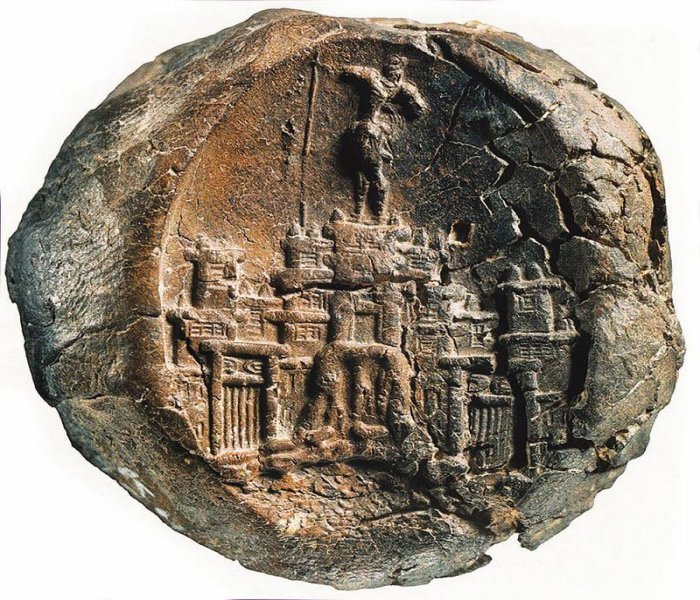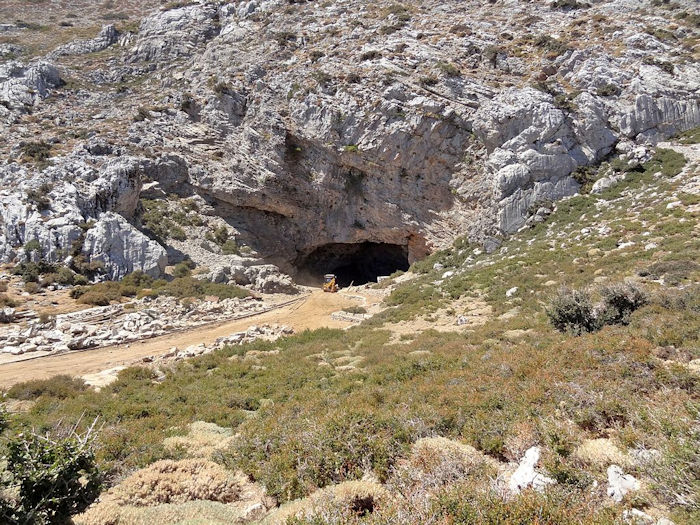Sophisticated Lenses Of Minoans Discovered In The Sacred Idaion (Ideon) Cave
A. Sutherland - AncientPages.com - The Minoans appeared to have possessed remarkable technologies; one of them was the creation of tiny, wonderful seals, which were skillfully carved out of soft stones, ivory, or bone.
Many such seals have been unearthed on Crete and more than 6,500 of them, stamped with more than 600 different and sophisticated designs, have been discovered at Phaistos.
A gold signet ring and its impression. Ashmolean Museum. Image credit: Andree Stephan - CC BY 3.0
Undoubtedly their creation required extraordinary skills of craftsmen and special tools.
Researchers have long wondered about technologies used by the ancient people. How, for example, did they make these tiny, microscopic engravings?
In her "Catalogue of Engraved Gems" Gisela Richter writes that the technique of gem engraving was known to the Minoans.
"It is important to know that only soft stones and metals can be worked for freehand with cutting tools; the harder stones require the wheel technique," she writes in her book.
This technique was known to the Minoans "who learned it perhaps from the Babylonians, by whom it was practiced at least as early as 1500 BC.
The Minoan object called "The Master's Seal" depicts a multistore building complex above the hill of Kasteli and a figure of a young man, perhaps a worshiper. Chania of Crete - 1600 BC. Image via Swedish Institute of Athens.
In "Selected Writings and a Bibliography," A. Hyatt Mayor writes that "the ancients knew and used the phenomenon of magnification…"
No doubt, in order to carve very small objects required special tools or at least one tool to magnify the surface with which the carver worked, especially if this surface was almost microscopic or "as tiny as a baby's thumb-nail."
At the entrance to the Ideon Cave can be seen the altar cut in the rock. Credit: Olaf Tausch - CC BY 3.0
"About 1600 BC, the Minoans invented seals of a double convex shape – the so-called lentoid gems that look like pills an inch or less across and half as thick. Before engraving the design on one side, both sides were probably polished…"
"When a Minoan craftsman polished a lentoid blank…, he had in his hand as good a short-focus lens as the man was to possess until Galileo's time…" (A. Hyatt Mayor).
The Minoans most probably used a great variety of magnifiers for their microscopic craftsmanship.
For example, in Minoan Crete, seals have been found with a complex carving on lentoid stones. The lentoid shape was one of the most commonly recovered seal shapes from Minoan Knossos on Crete dating to the Bronze Age.

Finds from the Ideon Cave. Left: A piece of gold jewelry - Right: Ivory seals. Image via Explore Crete
In his book "The Lost Empire of Atlantis: History's Greatest Mystery Revealed", Gavin Menzies writes that "one lens found on Crete can magnify up to seven times with perfect clarity…and many of the lenses had been discovered hidden in a sacred cave, known as 'the Idaion cave' (or "Ideon Andron") located on Mount Ida, the highest mountain in Crete, slightly northwest of Kamares, above the barren plateau of Nida.
It is one of the greatest cave sanctuaries in Crete, as important as the major Greek temples. It flourished in antiquity (4000 BC to the 1st century AD).
The Ideon Cave was famous for being where Zeus, the Father of the Gods, was born and grew up….
This cave may have also held a secret of enigmatic seals of Crete and perhaps we can wonder as Menzies does:
"What the Minoans have written on them? Were they navigation instructions? Were they maps of the stars or perhaps only ownership details? Some of the minutely inscribed seals seemed to show stellar constellations, like Orion…"
Updated on February 7, 2022
Written by – A. Sutherland AncientPages.com Staff Writer
Copyright © AncientPages.com All rights reserved. This material may not be published, broadcast, rewritten or redistributed in whole or part without the express written permission of AncientPages.com
Expand for referencesRichter, Catalogue of Engraved Gems
Menzies, The Lost Empire of Atlantis: History's Greatest Mystery Revealed
More From Ancient Pages
-
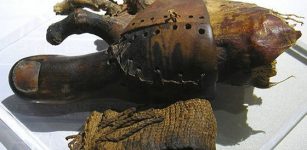 3,000-Year-Old Egyptian Artificial Wooden Toe In New Light
Archaeology | Jun 20, 2017
3,000-Year-Old Egyptian Artificial Wooden Toe In New Light
Archaeology | Jun 20, 2017 -
 Samurai – Powerful Skilled Warriors Who Loved Music, Art And Poetry
Featured Stories | Dec 9, 2017
Samurai – Powerful Skilled Warriors Who Loved Music, Art And Poetry
Featured Stories | Dec 9, 2017 -
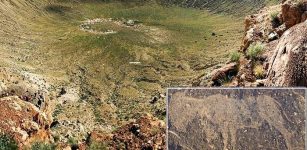 8,000-Year-Old Petroglyphs Discovered In Oldest Impact Crater In South Africa
Archaeology | Jun 21, 2019
8,000-Year-Old Petroglyphs Discovered In Oldest Impact Crater In South Africa
Archaeology | Jun 21, 2019 -
 Mighty Viking Harald Hardrada – The Last Great Viking And Most Feared Warrior Of His Time
Featured Stories | Jun 9, 2020
Mighty Viking Harald Hardrada – The Last Great Viking And Most Feared Warrior Of His Time
Featured Stories | Jun 9, 2020 -
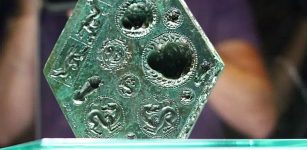 Unique 2,000-Year-Old Hexagonal-Shaped Bronze Matrix Of Sarmizegetusa Regia, Romania
Artifacts | Jan 7, 2016
Unique 2,000-Year-Old Hexagonal-Shaped Bronze Matrix Of Sarmizegetusa Regia, Romania
Artifacts | Jan 7, 2016 -
 Art Historians Solve Mystery Of Raphael’s Tomb By Reconstructing His Face
Archaeology | Aug 7, 2020
Art Historians Solve Mystery Of Raphael’s Tomb By Reconstructing His Face
Archaeology | Aug 7, 2020 -
 Enigma Of The Missing Pyramid Bodies – Ancient Egyptian Mystery Remains Unsolved
Ancient Mysteries | Dec 10, 2018
Enigma Of The Missing Pyramid Bodies – Ancient Egyptian Mystery Remains Unsolved
Ancient Mysteries | Dec 10, 2018 -
 Coyote: Hero, Trickster, Immortal And Respected Animal In Native American Myths
Featured Stories | May 10, 2016
Coyote: Hero, Trickster, Immortal And Respected Animal In Native American Myths
Featured Stories | May 10, 2016 -
 On This Day In History: Michael Servetus Burned At The Stake ‘Atop A Pyre Of His Own Books’ – On Oct 27, 1553
News | Oct 26, 2016
On This Day In History: Michael Servetus Burned At The Stake ‘Atop A Pyre Of His Own Books’ – On Oct 27, 1553
News | Oct 26, 2016 -
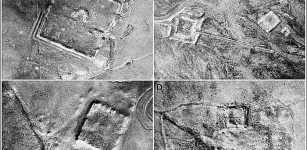 Did Roman Fortifications On Eastern Frontier Function As A Wall Or A Road?
Places | Feb 16, 2024
Did Roman Fortifications On Eastern Frontier Function As A Wall Or A Road?
Places | Feb 16, 2024 -
 5,000 Years Old Beer Enjoyed By Egyptian Pharaohs Recreated
Archaeology | May 23, 2019
5,000 Years Old Beer Enjoyed By Egyptian Pharaohs Recreated
Archaeology | May 23, 2019 -
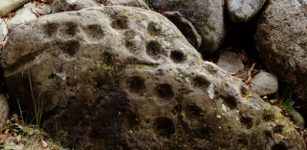 Largest Collection Of Ancient “Cup-Marked” Rocks Ever Found In Scotland
Civilizations | Nov 23, 2018
Largest Collection Of Ancient “Cup-Marked” Rocks Ever Found In Scotland
Civilizations | Nov 23, 2018 -
 Mysterious Hakkari Stelae: Were They Carved By Inhabitants Of Ancient Kingdom Of Hubushkia?
Artifacts | Nov 15, 2018
Mysterious Hakkari Stelae: Were They Carved By Inhabitants Of Ancient Kingdom Of Hubushkia?
Artifacts | Nov 15, 2018 -
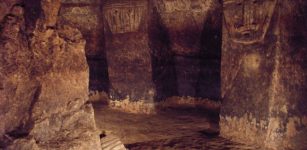 Huge Subterranean Pre-Columbian Shaft Tombs In Tierradentro, Colombia
Featured Stories | Apr 28, 2021
Huge Subterranean Pre-Columbian Shaft Tombs In Tierradentro, Colombia
Featured Stories | Apr 28, 2021 -
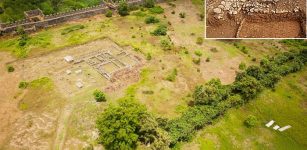 1,800-Year-Old Roman Winepress Found Near Roman Fort At Gonio (Apsaros), Georgia
Archaeology | Nov 23, 2022
1,800-Year-Old Roman Winepress Found Near Roman Fort At Gonio (Apsaros), Georgia
Archaeology | Nov 23, 2022 -
 Arborglyphs – Basque Immigrant Sheepherders Left Their Marks On Aspen Trees In The American West
Featured Stories | Jul 15, 2024
Arborglyphs – Basque Immigrant Sheepherders Left Their Marks On Aspen Trees In The American West
Featured Stories | Jul 15, 2024 -
 Ruins Of Roman Temple From Reign Of Emperor Antonius Pius Unearthed In Egypt
Archaeology | May 15, 2018
Ruins Of Roman Temple From Reign Of Emperor Antonius Pius Unearthed In Egypt
Archaeology | May 15, 2018 -
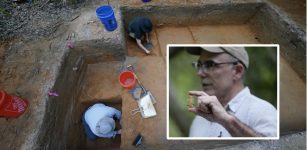 12,000-Year-Old Artifacts In Louisiana Saved By Scientists
Archaeology | Jul 18, 2023
12,000-Year-Old Artifacts In Louisiana Saved By Scientists
Archaeology | Jul 18, 2023 -
 Boreas – Mighty North Wind God In Greek Mythology
Featured Stories | Mar 26, 2023
Boreas – Mighty North Wind God In Greek Mythology
Featured Stories | Mar 26, 2023 -
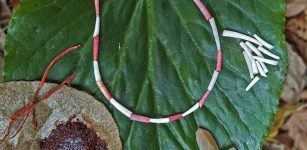 15,000-Year-Old Shell Beads Found Kebara Cave Are The Oldest Known Use Of Organic Red Pigments
Archaeology | Oct 27, 2023
15,000-Year-Old Shell Beads Found Kebara Cave Are The Oldest Known Use Of Organic Red Pigments
Archaeology | Oct 27, 2023


